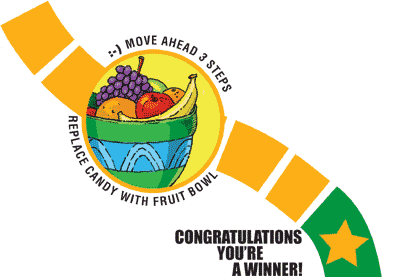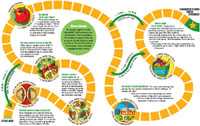How to Avoid Portion Size Pitfalls to Help Manage Your Weight
When eating at many restaurants, it's hard to miss that portion sizes have gotten larger in the last few years. The trend has also spilled over into the grocery store and vending machines, where a bagel has become a BAGEL and an "individual" bag of chips can easily feed more than one. Research shows that people unintentionally consume more calories when faced with larger portions. This can mean significant excess calorie intake, especially when eating high-calorie foods. Here are some tips to help you avoid some common portion-size pitfalls.
This is also available as a Print-friendly game board brochure [PDF-816KB].
Portion control when eating out. Many restaurants serve more food than one person needs at one meal. Take control of the amount of food that ends up on your plate by splitting an entrée with a friend. Or, ask the wait person for a "to-go" box and wrap up half your meal as soon as it's brought to the table.
Portion control when eating in. To minimize the temptation of second and third helpings when eating at home, serve the food on individual plates, instead of putting the serving dishes on the table. Keeping the excess food out of reach may discourage overeating.
Portion control in front of the TV. When eating or snacking in front of the TV, put the amount that you plan to eat into a bowl or container instead of eating straight from the package. It's easy to overeat when your attention is focused on something else.


Go ahead, spoil your dinner. We learned as children not to snack before a meal for fear of "spoiling our dinner." Well, it's time to forget that old rule. If you feel hungry between meals, eat a healthy snack, like a piece of fruit or small salad, to avoid overeating during your next meal.
Be aware of large packages. For some reason, the larger the package, the more people consume from it without realizing it. To minimize this effect:
- Divide up the contents of one large package into several smaller containers to help avoid over-consumption.
- Don't eat straight from the package. Instead, serve the food in a small bowl or container.

Out of sight, out of mind. People tend to consume more when they have easy access to food. Make your home a "portion friendly zone."
- Replace the candy dish with a fruit bowl.
- Store especially tempting foods, like cookies, chips, or ice cream, out of immediate eyesight, like on a high shelf or at the back of the freezer. Move the healthier food to the front at eye level.
- When buying in bulk, store the excess in a place that's not convenient to get to, such as a high cabinet or at the back of the pantry.
Related Resources
Check out these Web sites for more portion size tips:
- ChooseMyPlate is the federal government's nutrition education and guidance Web site and was developed as an effort to promote healthy eating and to encourage consumers to make healthy choices.
- Want to know the amount of each food group you need daily? Find out and receive a customized Daily Food Plan.
- The Portion Distortion Quiz from the National Heart Lung and Blood Institute (NHLBI) shows how portion sizes of some common foods have changed over the years.
Food labels can help you understand that portion sizes are often larger than you think. Click the link below to learn how to use the Nutrition Facts Label on food packages:
Do Increased Portion Sizes Affect How Much We Eat? Research to Practice Series No. 2 [PDF-245KB]
CDC, Nutrition and Physical Activity
This research-to-practice review examines what science underlies the notion that large portion sizes have contributed to weight gain among Americans. This section also offers ideas to practitioners about how to counsel their patients or clients about portion size.
- Page last reviewed: August 18, 2015
- Page last updated: July 6, 2016
- Content source:


 ShareCompartir
ShareCompartir
